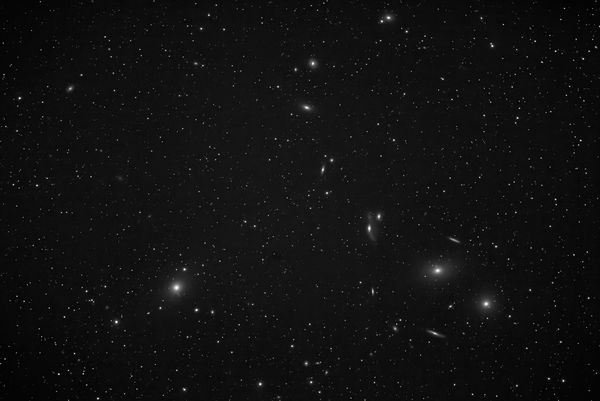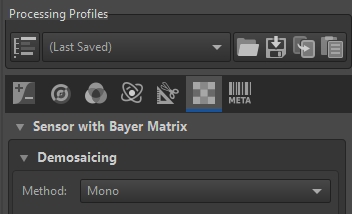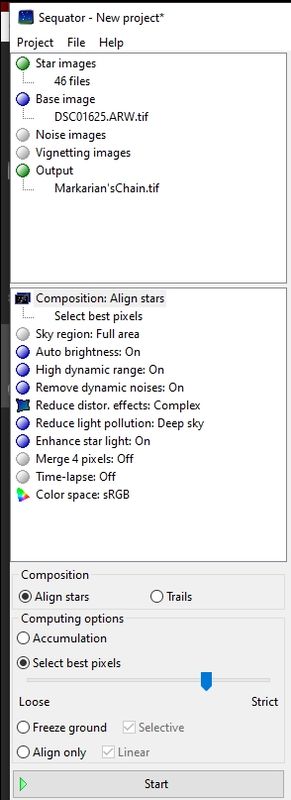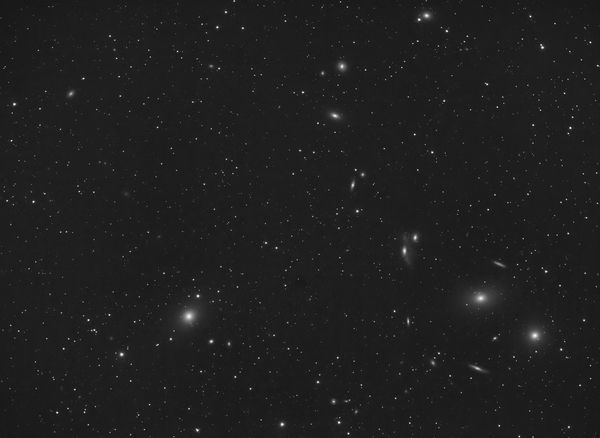Astrophotography with a Sony A6000(M)
Apr 28, 2020 21:30:39 #
An excellent few hours under the stars last night.
Set up the Sony A6000(M) (monochrome converted camera) with an Hutech HEUIB-II filter on an Astro-Tech 65EDQ telescope mounted on an Evolution Alt-Az mount. Used a Bahtinov mask to get a good focus using at first Venus then Arcturus. And away I went...
Shot multiple 30 sec. subs using various ISO setting. Preprocessed the subs in Monochrome2DNG then ran them through Lightroom for a bit of adjustment. Aligned, stacked, stretched, removed background gradient and did minor star reductions in PixInsight. Final postprocessing in Lightroom.
Using the HEUIB-II filter was a major improvement over no filters; much better control of star bloating.
Next step, some imaging with narrowband and/or LRGB filters.
Enjoy!
bwa
P.S.: Monochrome conversion done by Monochrome Imaging Services.
.
Set up the Sony A6000(M) (monochrome converted camera) with an Hutech HEUIB-II filter on an Astro-Tech 65EDQ telescope mounted on an Evolution Alt-Az mount. Used a Bahtinov mask to get a good focus using at first Venus then Arcturus. And away I went...
Shot multiple 30 sec. subs using various ISO setting. Preprocessed the subs in Monochrome2DNG then ran them through Lightroom for a bit of adjustment. Aligned, stacked, stretched, removed background gradient and did minor star reductions in PixInsight. Final postprocessing in Lightroom.
Using the HEUIB-II filter was a major improvement over no filters; much better control of star bloating.
Next step, some imaging with narrowband and/or LRGB filters.
Enjoy!
bwa
P.S.: Monochrome conversion done by Monochrome Imaging Services.
.
Whirlpool Galaxy(M51)(AT65EDQ,40x36sec,ISO1600)_PI_StarReduction_LR
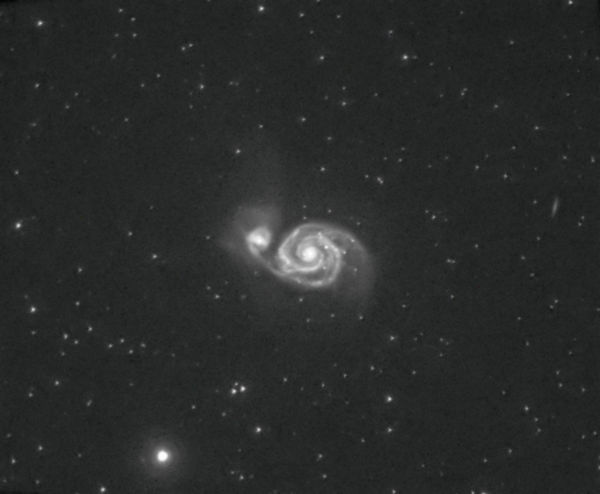
(Download)
Markarian's Chain of Galaxies(AT65EDQ,43x30sec,ISO3200)_PI_StarReduction_MStretch_ABE_LR
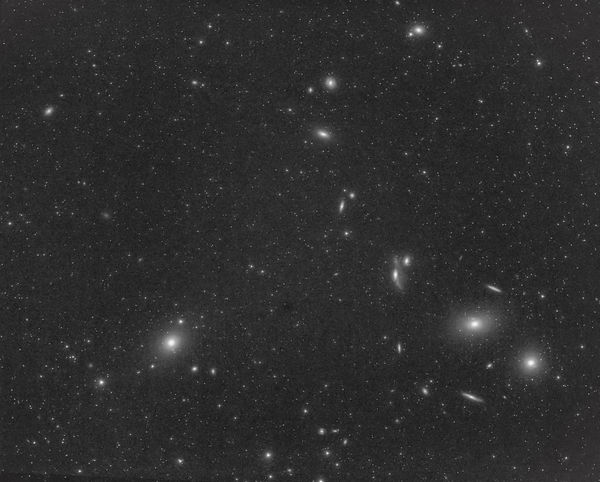
(Download)
Globular Star Cluster(M3)(AT65EDQ,36x30sec,ISO1600)_PI_StarReduction_MStretch_ABE_LR
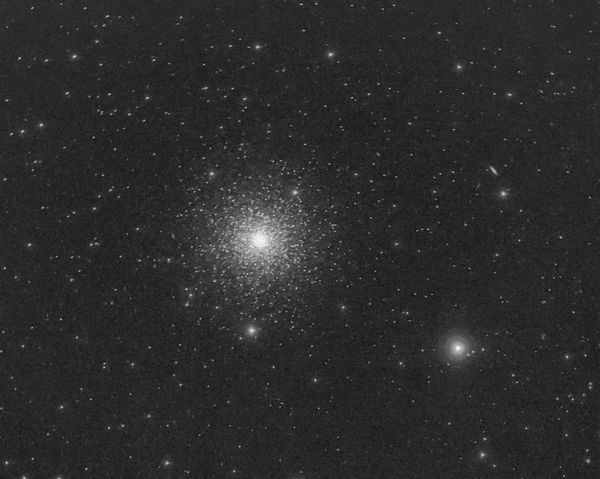
(Download)
Globular Star Cluster(M53 and NGC5053)(AT65EDQ,43x30sec,ISO1600)_PI_StarReduction_MStretch_ABE_LR
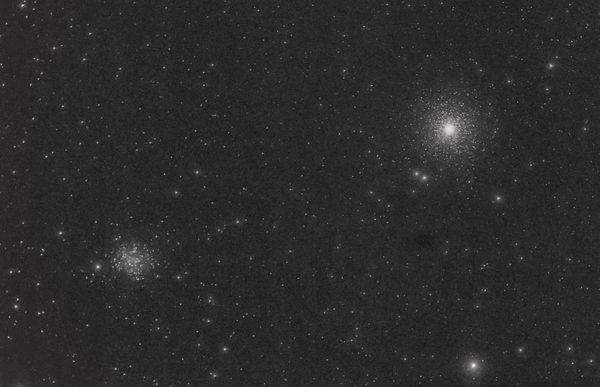
(Download)
Comet Atlas C2019 Y4(AT65EDQ,115x30sec,ISO20000)_PI_StarReduction_MStretch_ABE_LR
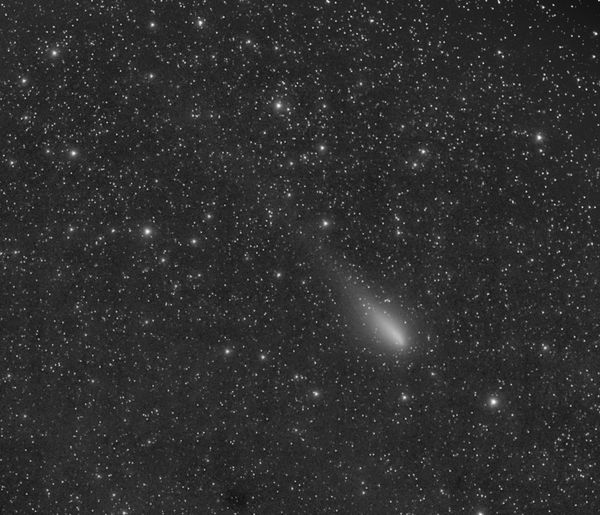
(Download)
Moon-EarthGlow_IP__ExcAvg_PS
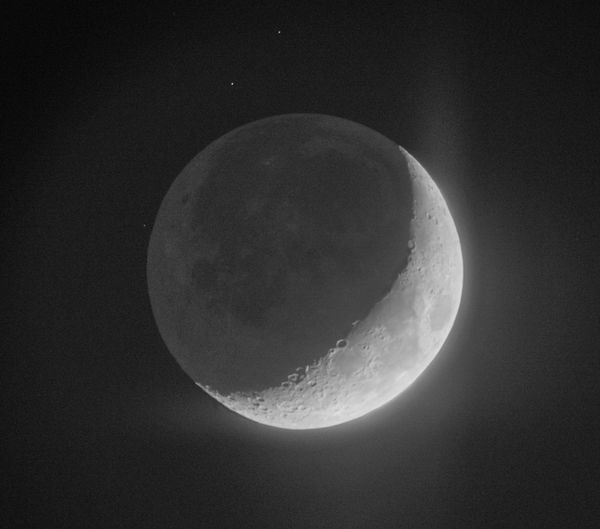
(Download)
Apr 28, 2020 22:02:52 #
bwana wrote:
An excellent few hours under the stars last night.... (show quote)
bwa, Outstanding images. Thanks for sharing them and your technique.
Apr 28, 2020 22:06:05 #
PixelStan77 wrote:
bwa, Outstanding images. Thanks for sharing them and your technique.
Thanks for looking and commenting... bwa
Apr 29, 2020 08:09:06 #
Nice shots!! You did these with a camera and lens? What size lens did you use. I like the idea of converting to mono - I use mono camera for my solar shots (necessary since H-a images are red only). I was surprised to see you use an alt-az mount. Well done!! Thanks for sharing!
Jon
Jon
Apr 29, 2020 14:05:19 #
fjwallace wrote:
Nice shots!! You did these with a camera and lens? What size lens did you use. I like the idea of converting to mono - I use mono camera for my solar shots (necessary since H-a images are red only). I was surprised to see you use an alt-az mount. Well done!! Thanks for sharing!
Jon
Jon
I used a Astro-Tech 65EDQ telescope (422mm, f/6.5).
I do have a Celestron AVX (EQ) mount for use on a garage pad and a Celestron CGEM-DX (EQ) mount in an observatory but for new system testing I normally operate off my deck with the Evolution mount; easy setup and no power required.
I'm assuming your 'solar shots' are with an Ha solar scope since you mention they are red only. I shoot both White Light and Ha solar with a QHY 183C(olor) camera. I've also used both a Sony A6100 and A7 III for both, and a RX IV for White Light solar. All seem to work quite well. I haven't tried the A6000(M) for solar to this point but it should work very well? The Sun is a little boring at present...
Stay safe and healthy!
bwa
Apr 29, 2020 22:39:07 #
bwana wrote:
An excellent few hours under the stars last night.... (show quote)
What a difference a mono sensor makes! Very nice.
Apr 30, 2020 04:32:12 #
May 11, 2020 13:41:24 #
I am posting the Markarian's Chain using 46 RAW images that Brian (bwana) sent me in order to try what I could do with these mono files. I am very pleased with the mono files and will share how I processed them.
For stacking, I used a free stacking program called Sequator which can be found here: https://sites.google.com/site/sequatorglobal/download
But before I stacked them, I had to do something with the monochrome files, The camera was modified by removing the Bayer Matrix Filter. But the camera doesn't know that it has been modified and produces a RAW file thinking that it still had the Bayer Matrix. If the RAW files were to be processed with software that treats these files as a normal RAW file, then it would attempt to Debayer the RAW file, and this would destroy the added detail that comes from a mono file.
To do this, I used another free program called RawTherapy to convert the RAW files into a TIF file without doing a debaying. Here is where RawTherapee can be found: http://rawtherapee.com/
Here is a view of the editing panel of RawTherapee where mono is chosen in the Demosaicing section. Also in here are about 13 different Demosaicing options, but those are not what we want to use. And without doing anything else with the file, I saved it as TIF in uncompressed format (Sequator doesn't like compressed TIF files).
I am also showing a setup panel for Sequator with the settings I used.
You can see 46 star images are loaded and there is one base image. Brian told me that DSC01625 was shot at ISO 1600 and all the others at ISO 3200, I selected that one to be my base image. Note the name of the file includes RAW. But RawTherapee had just appended .tif onto the end.
I didn't have any Noise Images (i.e. Dark Frames) and no Vignetting images, thus they weren't entered.
Note that for Composition, I selected Align Stars and Select best Pixels and moved the slide to about the 3/4 position.
And for Reduce light pollution, I selected Deep Sky and set the strength at about 3/4 also.
I then hit the start button and let it run.
The result came out looking real good, but I did treat the noise with Topaz Denoise AI. I also cropped a bit of the edge since this was a stack, and in Lightroom, boosted the contrast and clarity just a bit. But I didn't stretch.
Overall, I am quite impressed with using mono RAW files.
For stacking, I used a free stacking program called Sequator which can be found here: https://sites.google.com/site/sequatorglobal/download
But before I stacked them, I had to do something with the monochrome files, The camera was modified by removing the Bayer Matrix Filter. But the camera doesn't know that it has been modified and produces a RAW file thinking that it still had the Bayer Matrix. If the RAW files were to be processed with software that treats these files as a normal RAW file, then it would attempt to Debayer the RAW file, and this would destroy the added detail that comes from a mono file.
To do this, I used another free program called RawTherapy to convert the RAW files into a TIF file without doing a debaying. Here is where RawTherapee can be found: http://rawtherapee.com/
Here is a view of the editing panel of RawTherapee where mono is chosen in the Demosaicing section. Also in here are about 13 different Demosaicing options, but those are not what we want to use. And without doing anything else with the file, I saved it as TIF in uncompressed format (Sequator doesn't like compressed TIF files).
I am also showing a setup panel for Sequator with the settings I used.
You can see 46 star images are loaded and there is one base image. Brian told me that DSC01625 was shot at ISO 1600 and all the others at ISO 3200, I selected that one to be my base image. Note the name of the file includes RAW. But RawTherapee had just appended .tif onto the end.
I didn't have any Noise Images (i.e. Dark Frames) and no Vignetting images, thus they weren't entered.
Note that for Composition, I selected Align Stars and Select best Pixels and moved the slide to about the 3/4 position.
And for Reduce light pollution, I selected Deep Sky and set the strength at about 3/4 also.
I then hit the start button and let it run.
The result came out looking real good, but I did treat the noise with Topaz Denoise AI. I also cropped a bit of the edge since this was a stack, and in Lightroom, boosted the contrast and clarity just a bit. But I didn't stretch.
Overall, I am quite impressed with using mono RAW files.
May 13, 2020 21:55:17 #
Adding an effort using Nebulosity 4 to do the stacking.
For this effort, I used an application called monochrome2dng to convert the RAW files into monochrome DNG files which I used for inputs to Nebulosity. Sequator.exe doesn't use the DNG files, so I used RawTherapee to convert to uncompressed TIFF files which also were about 140 MB vs about 25 MB for the DNG files. As a note, the files do need to be converted since the camera thinks that it is saving color files, and we want to avoid the files being subjected to demosaicing. Both methods, monochrome2dng and RawTherapee, accomplish the same result - one as DNG and the other as TIFF.
It looks like Nebulosity did a better job of pulling out the diffuse outer regions of the various galaxies, but was more work than using Sequator.
For this effort, I used an application called monochrome2dng to convert the RAW files into monochrome DNG files which I used for inputs to Nebulosity. Sequator.exe doesn't use the DNG files, so I used RawTherapee to convert to uncompressed TIFF files which also were about 140 MB vs about 25 MB for the DNG files. As a note, the files do need to be converted since the camera thinks that it is saving color files, and we want to avoid the files being subjected to demosaicing. Both methods, monochrome2dng and RawTherapee, accomplish the same result - one as DNG and the other as TIFF.
It looks like Nebulosity did a better job of pulling out the diffuse outer regions of the various galaxies, but was more work than using Sequator.
If you want to reply, then register here. Registration is free and your account is created instantly, so you can post right away.


